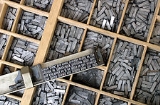
Typesetting
Encyclopedia
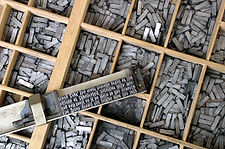
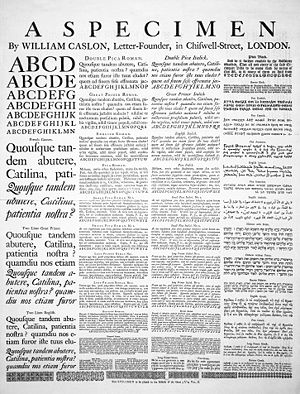
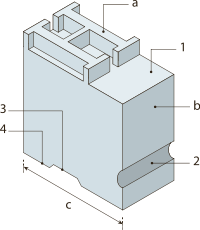
Written language
A written language is the representation of a language by means of a writing system. Written language is an invention in that it must be taught to children, who will instinctively learn or create spoken or gestural languages....
by means of types
Sort (typesetting)
In typesetting by hand compositing, a sort is a piece of type representing a particular letter or symbol, cast from a matrix mould and assembled with other sorts bearing additional letters into lines of type to make up a forme from which a page is printed.-See also:* History of western typography*...
.
Typesetting requires the prior process of designing a font
Font
In typography, a font is traditionally defined as a quantity of sorts composing a complete character set of a single size and style of a particular typeface...
and storing it in some manner. Typesetting is the retrieval of the stored letters (called sorts in mechanical systems and glyphs in digital systems) and the ordering of them according to a language's orthography for visual display.
Letterpress era
During the letterpress era, moveable type was composed by hand for each pagePage
-Position or occupation:* Page , a traditionally young male servant* Page * Page of Honour, a ceremonial position in the Royal Household of the Sovereign of the United Kingdom* A participant in any of the following programs:...
. Cast metal sorts
Sort (typesetting)
In typesetting by hand compositing, a sort is a piece of type representing a particular letter or symbol, cast from a matrix mould and assembled with other sorts bearing additional letters into lines of type to make up a forme from which a page is printed.-See also:* History of western typography*...
were composited into words and lines of text and tightly bound together to make up a page image called a forme, with all letter faces exactly the same height to form an even surface of type. The forme was mounted in a press, inked, and an impression made on paper.
The diagram at right illustrates a cast metal sort: a face, b body or shank, c point size, 1 shoulder, 2 nick, 3 groove, 4 foot. Wooden printing sorts were in use for centuries in combination with metal type.
Copies of formes were cast when anticipating subsequent printings of a text, freeing the costly type for other work. In this process, called stereotyping
Stereotype (printing)
In printing, a stereotype, also known as a cliché, stereoplate or simply a stereo, was originally a "solid plate or type-metal, cast from a papier-mâché or plaster mould taken from the surface of a forme of type" used for printing instead of the original...
, the entire forme is pressed into a fine matrix such as plaster of Paris or papier mâché called Flong to create a positive, from which the stereotype forme was cast of type metal.
Hand composing was rendered commercially obsolete by continuous casting or hot-metal typesetting
Hot metal typesetting
In printing and typography, hot metal typesetting refers to 19th-century technologies for typesetting text in letterpress printing. This method injects molten type metal into a mold that has the shape of one or more glyphs...
machines such as the Linotype machine
Linotype machine
The Linotype typesetting machine is a "line casting" machine used in printing. The name of the machine comes from the fact that it produces an entire line of metal type at once, hence a line-o'-type, a significant improvement over manual typesetting....
and Monotype at the end of the 19th century. The Linotype, invented by Ottmar Mergenthaler
Ottmar Mergenthaler
Ottmar Mergenthaler was an inventor who has been called a second Gutenberg because of his invention of the Linotype machine, the first device that could easily and quickly set complete lines of type for use in printing presses...
, enabled one machine operator to do the work of ten hand compositors by automating the selection, use and replacement of sorts, with a keyboard as input. Later advances such as the typewriter
Typewriter
A typewriter is a mechanical or electromechanical device with keys that, when pressed, cause characters to be printed on a medium, usually paper. Typically one character is printed per keypress, and the machine prints the characters by making ink impressions of type elements similar to the pieces...
and computer
Computer
A computer is a programmable machine designed to sequentially and automatically carry out a sequence of arithmetic or logical operations. The particular sequence of operations can be changed readily, allowing the computer to solve more than one kind of problem...
would push the state of the art even farther ahead. Still, hand composition and letterpress printing did not fall completely out of use, and since the introduction of digital typesetting, it has seen a revival as an artisanal pursuit. However, it is a very small niche within the larger typesetting market.
Phototypesetting

Phototypesetting
Phototypesetting was a method of setting type, rendered obsolete with the popularity of the personal computer and desktop publishing software, that uses a photographic process to generate columns of type on a scroll of photographic paper...
systems first appeared in the early 1960s and rapidly displaced continuous casting machines. These devices consisted of glass disks (one per font) that spun in front of a light source which selectively exposed characters onto light-sensitive paper. Originally they were driven by pre-punched paper tapes. Later they were hooked up to computer front ends.
One of the earliest electronic photocomposition systems was introduced by Fairchild Semiconductor
Fairchild Semiconductor
Fairchild Semiconductor International, Inc. is an American semiconductor company based in San Jose, California. Founded in 1957, it was a pioneer in transistor and integrated circuit manufacturing...
. The typesetter typed a line of text on a Fairchild keyboard that had no display. To verify correct content of the line it was typed a second time. If the two lines were identical a bell rang and the machine produced a punched paper tape
Punched tape
Punched tape or paper tape is an obsolete form of data storage, consisting of a long strip of paper in which holes are punched to store data...
corresponding to the text. With the completion of a block of lines the typesetter fed the corresponding paper tapes into a phototypesetting device which mechanically set type outlines printed on glass sheets into place for exposure onto a negative film
Film
A film, also called a movie or motion picture, is a series of still or moving images. It is produced by recording photographic images with cameras, or by creating images using animation techniques or visual effects...
. Photosensitive paper was exposed to light through the negative film, resulting in a column of black type on white paper, or a galley
Galley proof
In printing and publishing, proofs are the preliminary versions of publications meant for review by authors, editors, and proofreaders, often with extra wide margins. Galley proofs may be uncut and unbound, or in some cases electronic...
. The galley was then cut up and used to create a mechanical drawing or paste up
Paste up
Paste up refers to a method of creating or laying out publication pages that predates the use of the now-standard computerized page design desktop publishing programs. Completed, or camera-ready, pages are known as mechanicals or mechanical art...
of a whole page. A large film negative of the page is shot and used to make plates for offset printing
Offset printing
Offset printing is a commonly used printing technique in which the inked image is transferred from a plate to a rubber blanket, then to the printing surface...
.
Digital era
The next generation of phototypesetting machines to emerge were those that generated characters on a Cathode ray tubeCathode ray tube
The cathode ray tube is a vacuum tube containing an electron gun and a fluorescent screen used to view images. It has a means to accelerate and deflect the electron beam onto the fluorescent screen to create the images. The image may represent electrical waveforms , pictures , radar targets and...
. Typical of the type were the Alphanumeric APS2 (1963), IBM 2680 (1967), I.I.I. VideoComp (1973?), Linotron 202 (1978), and Autologic APS5 (1980?). These machines were the mainstay of phototypesetting for much of the 1970s and 1980s. Such machines could be 'driven online' by a computer front-end system or take their data from magnetic tape. Type fonts were stored digitally on conventional magnetic disk drives.
Computer
Computer
A computer is a programmable machine designed to sequentially and automatically carry out a sequence of arithmetic or logical operations. The particular sequence of operations can be changed readily, allowing the computer to solve more than one kind of problem...
s excel at automatically typesetting documents. Character-by-character computer-aided phototypesetting
Phototypesetting
Phototypesetting was a method of setting type, rendered obsolete with the popularity of the personal computer and desktop publishing software, that uses a photographic process to generate columns of type on a scroll of photographic paper...
was in turn rapidly rendered obsolete in the 1980s by fully digital systems employing a raster image processor
Raster image processor
A raster image processor is a component used in a printing system which produces a raster image also known as a bitmap. The bitmap is then sent to a printing device for output. The input may be a page description in a high-level page description language such as PostScript, Portable Document...
to render
Rendering (computer graphics)
Rendering is the process of generating an image from a model , by means of computer programs. A scene file contains objects in a strictly defined language or data structure; it would contain geometry, viewpoint, texture, lighting, and shading information as a description of the virtual scene...
an entire page to a single high-resolution digital image
Digital image
A digital image is a numeric representation of a two-dimensional image. Depending on whether or not the image resolution is fixed, it may be of vector or raster type...
, now known as imagesetting.
The first commercially successful laser imagesetter, able to make use of a raster image processor was the Monotype Lasercomp. ECRM, Compugraphic (later purchased by Agfa) and others rapidly followed suit with machines of their own.
Early minicomputer-based typesetting software introduced in the 1970s and early 1980s such as Datalogics Pager, Penta, Miles 33, Xyvision, troff from Bell Labs, and IBM's Script product with CRT terminals, were better able to drive these electro-mechanical devices, and used text markup language
Markup language
A markup language is a modern system for annotating a text in a way that is syntactically distinguishable from that text. The idea and terminology evolved from the "marking up" of manuscripts, i.e. the revision instructions by editors, traditionally written with a blue pencil on authors' manuscripts...
s to describe type
Typeface
In typography, a typeface is the artistic representation or interpretation of characters; it is the way the type looks. Each type is designed and there are thousands of different typefaces in existence, with new ones being developed constantly....
and other page formatting information. The descendants of these text markup languages include SGML, XML
XML
Extensible Markup Language is a set of rules for encoding documents in machine-readable form. It is defined in the XML 1.0 Specification produced by the W3C, and several other related specifications, all gratis open standards....
and HTML
HTML
HyperText Markup Language is the predominant markup language for web pages. HTML elements are the basic building-blocks of webpages....
.
The minicomputer systems output columns of text on film for paste-up and eventually produced entire pages and signature
Signature
A signature is a handwritten depiction of someone's name, nickname, or even a simple "X" that a person writes on documents as a proof of identity and intent. The writer of a signature is a signatory. Similar to a handwritten signature, a signature work describes the work as readily identifying...
s of 4, 8, 16 or more pages using imposition
Imposition
Imposition is one of the fundamental steps in the prepress printing process. It consists in the arrangement of the printed product’s pages on the printer’s sheet, in order to obtain faster printing, simplified binding and less waste of paper....
software on devices such as the Israeli-made Scitex Dolev. The data stream used by these systems to drive page layout on printers and imagesetters led to the development of printer control languages such as Adobe Systems
Adobe Systems
Adobe Systems Incorporated is an American computer software company founded in 1982 and headquartered in San Jose, California, United States...
PostScript
PostScript
PostScript is a dynamically typed concatenative programming language created by John Warnock and Charles Geschke in 1982. It is best known for its use as a page description language in the electronic and desktop publishing areas. Adobe PostScript 3 is also the worldwide printing and imaging...
and Hewlett-Packard's HP PCL
Printer Command Language
Printer Command Language, more commonly referred to as PCL, is a page description language developed by Hewlett-Packard as a printer protocol and has become a de facto industry standard. Originally developed for early inkjet printers in 1984, PCL has been released in varying levels for thermal,...
.
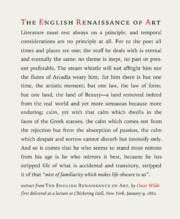
In 1985, desktop publishing
Desktop publishing
Desktop publishing is the creation of documents using page layout software on a personal computer.The term has been used for publishing at all levels, from small-circulation documents such as local newsletters to books, magazines and newspapers...
became available, starting with the Apple Macintosh, Aldus PageMaker
Adobe PageMaker
PageMaker was one of the first desktop publishing programs, introduced in 1985 by Aldus Corporation, initially for the then-new Apple Macintosh and in 1987 for PCs running Windows 1.0....
(and later QuarkXPress
QuarkXPress
QuarkXPress is a computer application for creating and editing complex page layouts in a WYSIWYG environment. It runs on Mac OS X and Windows. It was first released by Quark, Inc...
) and PostScript
PostScript
PostScript is a dynamically typed concatenative programming language created by John Warnock and Charles Geschke in 1982. It is best known for its use as a page description language in the electronic and desktop publishing areas. Adobe PostScript 3 is also the worldwide printing and imaging...
. Improvements in software and hardware, and rapidly-lowering costs, popularized desktop publishing and enabled very fine control of typeset results much less expensively than the minicomputer dedicated systems. At the same time, word processing systems such as Wang
Wang Laboratories
Wang Laboratories was a computer company founded in 1951 by Dr. An Wang and Dr. G. Y. Chu. The company was successively headquartered in Cambridge , Tewksbury , and finally in Lowell, Massachusetts . At its peak in the 1980s, Wang Laboratories had annual revenues of $3 billion and employed over...
and WordPerfect
WordPerfect
WordPerfect is a word processing application, now owned by Corel.Bruce Bastian, a Brigham Young University graduate student, and BYU computer science professor Dr. Alan Ashton joined forces to design a word processing system for the city of Orem's Data General Corp. minicomputer system in 1979...
revolutionized office documents. They did not, however, have the typographic ability or flexibility required for complicated book layout, graphics, mathematics, or advanced hyphenation and justification rules (H and J).
By the year 2000 this industry segment had shrunk because publishers were now capable of integrating typesetting and graphic design on their own in-house computers. Many found that the cost of maintaining high standards of typographic design and technical skill made it more economical to out-source to freelancers and graphic design specialists.
The availability of cheap, or free, font
Font
In typography, a font is traditionally defined as a quantity of sorts composing a complete character set of a single size and style of a particular typeface...
s made the conversion to do-it-yourself easier but also opened up a gap between skilled designers and amateurs. The advent of PostScript
PostScript
PostScript is a dynamically typed concatenative programming language created by John Warnock and Charles Geschke in 1982. It is best known for its use as a page description language in the electronic and desktop publishing areas. Adobe PostScript 3 is also the worldwide printing and imaging...
, supplemented by the PDF
Portable Document Format
Portable Document Format is an open standard for document exchange. This file format, created by Adobe Systems in 1993, is used for representing documents in a manner independent of application software, hardware, and operating systems....
file format, provided a universal method of proofing designs and layouts, readable on major computer and operating systems.
SCRIPT variants
IBM created and inspired a family of typesetting languages with names that were derivatives of the word "SCRIPT". Latter versions of SCRIPT included advanced features such as automatic generation of a table of contents and index, multi-column page layout, footnotes, boxes, automatic hyphenation and spelling verification.NSCRIPT was a port of SCRIPT to OS and TSO from CP-67/CMS SCRIPT.
Waterloo Script was created at the University of Waterloo later. One version of SCRIPT was created at MIT and the AA/CS at UW took over project development in 1974. The program was first used at UW in 1975. In the 1970s, SCRIPT was the only practical way to word process and format documents using a computer. By the late 1980s, the SCRIPT system had been extended to incorporate various upgrades.
The initial implementation of SCRIPT at UW was documented in the May 1975 Issue of the Computing Centre Newsletter which noted some the advantages of using SCRIPT:
a) Footnotes are handled easily.
b) Page numbers can be in Arabic or Roman numerals, and can appear at the top or bottom of the page, in the centre, on the left or on the right, or even-numbered pages and on the right for odd-numbered pages.
c) Underscoring or over striking can be made a function of SCRIPT, thus uncomplicating Editor functions.
d) SCRIPT files are regular OS databases or CMS files.
e) Output can be obtained on the printer, or at the terminal…”
The article also pointed out that SCRIPT had over 100 commands to assist in formatting documents, though 8 to 10 of these commands were sufficient to complete most formatting jobs. Thus SCRIPT had many of the capabilities that computer users generally associate with contemporary word processors.
SCRIPT/VS was a SCRIPT variant developed at IBM in the 1980s.
Script is still available from IBM as part of the Document Composition Facility for the z/OS
Z/OS
z/OS is a 64-bit operating system for mainframe computers, produced by IBM. It derives from and is the successor to OS/390, which in turn followed a string of MVS versions.Starting with earliest:*OS/VS2 Release 2 through Release 3.8...
operating system.
SGML and XML systems
SGML (the Standard Generalized markup Language) was based upon GMLGML
GML may refer to:* Middle Low German , a language used around the North Sea and the Baltic Sea from 1100 to 1600* Gostomel Airport , an international cargo airport, near Kiev, Ukraine* Gradient Multi-Layer nano-film...
(IBM Generalized Markup Language). GML was a set of macros on top of IBM Script.
The arrival of SGML/XML
XML
Extensible Markup Language is a set of rules for encoding documents in machine-readable form. It is defined in the XML 1.0 Specification produced by the W3C, and several other related specifications, all gratis open standards....
as the document model made other typesetting engines popular. Such engines include RenderX's
RenderX
RenderX, Inc is a commercial software development company that provides standards-based software products, used for typeset-quality electronic and print output of business content...
XEP
XEP
XEP is a commercial XSL-FO layout engine written in Java mainly used to convert XML to PDF. XEP is proprietary software by RenderX.- History :...
, Datalogics Pager, Penta, Miles 33's OASYS, Xyvision's XML Professional Publisher (XPP)
XML Professional Publisher (XPP)
XML Professional Publisher is an automated XML based publishing system that was developed out of a proprietary typesetting system.XPP is a standards-based, content formatting and publishing application for the automatic composition, transformation, and rendering of XML, SGML or tagged ASCII...
, FrameMaker
FrameMaker
Adobe FrameMaker is a document processor for the production and manipulation of large structured documents. It is produced by Adobe Systems. Although FrameMaker has evolved slowly in recent years, it maintains a strong following among professional technical writers.- Overview :FrameMaker has more...
, Arbortext, YesLogic's Prince
Prince XML
Prince is a proprietary software program that converts XML and HTML documents into PDF files by applying Cascading Style Sheets . It is developed by YesLogic, a small company based in Melbourne, Australia.-History:...
, QuarkXPress
QuarkXPress
QuarkXPress is a computer application for creating and editing complex page layouts in a WYSIWYG environment. It runs on Mac OS X and Windows. It was first released by Quark, Inc...
and Adobe InDesign. These products allow users to program their typesetting process around the SGML/XML with the help of scripting languages. Some of them, such as Arbortext Editor and XMetaL
XMetaL
XMetaL, or XMetaL Author, is a software application used for creating and editing documents in XML and SGML. It has some features common to word processors, but is a native XML editor that can be configured to work with various standard and custom DTDs and XML Schema...
Author, provide attractive WYSIWYG
WYSIWYG
WYSIWYG is an acronym for What You See Is What You Get. The term is used in computing to describe a system in which content displayed onscreen during editing appears in a form closely corresponding to its appearance when printed or displayed as a finished product...
-ish interfaces with support for XML standards and Unicode
Unicode
Unicode is a computing industry standard for the consistent encoding, representation and handling of text expressed in most of the world's writing systems...
to attract a wider spectrum of users.
Troff and successors
During the mid-1970s Joseph Ossanna, working at Bell Laboratories, wrote the troff typesetting program to drive a Wang C/A/T phototypesetter owned by the Labs; it was later enhanced by Brian KernighanBrian Kernighan
Brian Wilson Kernighan is a Canadian computer scientist who worked at Bell Labs alongside Unix creators Ken Thompson and Dennis Ritchie and contributed to the development of Unix. He is also coauthor of the AWK and AMPL programming languages. The 'K' of K&R C and the 'K' in AWK both stand for...
to support output to different equipment such as laser printer
Laser printer
A laser printer is a common type of computer printer that rapidly produces high quality text and graphics on plain paper. As with digital photocopiers and multifunction printers , laser printers employ a xerographic printing process, but differ from analog photocopiers in that the image is produced...
s and the like. While its use has fallen off, it is still included with a number of Unix
Unix
Unix is a multitasking, multi-user computer operating system originally developed in 1969 by a group of AT&T employees at Bell Labs, including Ken Thompson, Dennis Ritchie, Brian Kernighan, Douglas McIlroy, and Joe Ossanna...
and Unix-like
Unix-like
A Unix-like operating system is one that behaves in a manner similar to a Unix system, while not necessarily conforming to or being certified to any version of the Single UNIX Specification....
systems and has been used to typeset a number of high-profile technical and computer books. Some versions, as well as a GNU
GNU
GNU is a Unix-like computer operating system developed by the GNU project, ultimately aiming to be a "complete Unix-compatible software system"...
work-alike called groff
Groff (software)
Groff is the GNU replacement for the troff and nroff text formatters. It is an original implementation written primarily in C++ by James Clark and is modeled after ditroff, including many extensions. The first version, 0.3.1, was released June 1990. The first stable version, 1.04, was announced in...
, are now open source
Open source
The term open source describes practices in production and development that promote access to the end product's source materials. Some consider open source a philosophy, others consider it a pragmatic methodology...
.
TeX and LaTeX

The TeX
TeX
TeX is a typesetting system designed and mostly written by Donald Knuth and released in 1978. Within the typesetting system, its name is formatted as ....
system, developed by Donald E. Knuth at the end of 70s, is another widespread and powerful automated typesetting system that has set high standards, especially for typesetting mathematics. TeX is considered fairly difficult to learn on its own, and deals more with appearance than structure. The LaTeX
LaTeX
LaTeX is a document markup language and document preparation system for the TeX typesetting program. Within the typesetting system, its name is styled as . The term LaTeX refers only to the language in which documents are written, not to the editor used to write those documents. In order to...
macro package written by Leslie Lamport
Leslie Lamport
Leslie Lamport is an American computer scientist. A graduate of the Bronx High School of Science, he received a B.S. in mathematics from the Massachusetts Institute of Technology in 1960, and M.A. and Ph.D. degrees in mathematics from Brandeis University, respectively in 1963 and 1972...
at the beginning of the 80s offered a simpler interface, and an easier way to systematically encode the structure of a document. LaTeX markup is very widely used in academic circles for published papers and even books. Although standard TeX does not provide an interface of any sort there are programs that do. These programs includes Scientific Workplace
Scientific WorkPlace
Scientific WorkPlace is a software package for scientific word processing on Microsoft Windows. It is shipped as a WYSIWYG LaTeX-based word processor, together with the LaTeX document preparation system and an optional computer algebra system.Scientific WorkPlace allows one to edit and typeset...
, TeXmacs which are WYSIWYG
WYSIWYG
WYSIWYG is an acronym for What You See Is What You Get. The term is used in computing to describe a system in which content displayed onscreen during editing appears in a form closely corresponding to its appearance when printed or displayed as a finished product...
editors and LyX
LyX
LyX is a document processor following the self-coined "what you see is what you mean" paradigm , as opposed to the WYSIWYG ideas used by word processors...
which is a WYSIWYM
WYSIWYM
WYSIWYM is an acronym for What You See Is What You Mean, and refers to a paradigm for document editing...
editor.
See also
- Composing stickComposing stickIn letterpress printing and typesetting, a composing stick is an instrument used to assemble pieces of metal type into words and lines which are later bound into a forme, set in a galley and printed...
- DingbatDingbatA dingbat is an ornament, character or spacer used in typesetting, sometimes more formally known as a "printer's ornament" or "printer's character"....
- Hot metal typesettingHot metal typesettingIn printing and typography, hot metal typesetting refers to 19th-century technologies for typesetting text in letterpress printing. This method injects molten type metal into a mold that has the shape of one or more glyphs...
- Justification (typesetting)Justification (typesetting)In typesetting, justification is the typographic alignment setting of text or images within a column or "measure" to align along both the left and right margin...
- Ligature (typography)Ligature (typography)In writing and typography, a ligature occurs where two or more graphemes are joined as a single glyph. Ligatures usually replace consecutive characters sharing common components and are part of a more general class of glyphs called "contextual forms", where the specific shape of a letter depends on...
- PrintingPrintingPrinting is a process for reproducing text and image, typically with ink on paper using a printing press. It is often carried out as a large-scale industrial process, and is an essential part of publishing and transaction printing....
- Printing pressPrinting pressA printing press is a device for applying pressure to an inked surface resting upon a print medium , thereby transferring the ink...
- Sort (typesetting)Sort (typesetting)In typesetting by hand compositing, a sort is a piece of type representing a particular letter or symbol, cast from a matrix mould and assembled with other sorts bearing additional letters into lines of type to make up a forme from which a page is printed.-See also:* History of western typography*...
- Strut (typesetting)Strut (typesetting)In typesetting, a strut is an invisible character or element, used to ensure that a text has a minimum height and depth, even if no other elements are included.For example, LaTeX and plainTeX provide the command \strutto insert a font size specific strut...
- Technical writingTechnical writingTechnical writing, a form of technical communication, is a style of writing used in fields as diverse as computer hardware and software, engineering, chemistry, the aerospace industry, robotics, finance, consumer electronics, and biotechnology....
- TypefaceTypefaceIn typography, a typeface is the artistic representation or interpretation of characters; it is the way the type looks. Each type is designed and there are thousands of different typefaces in existence, with new ones being developed constantly....
- TypographyTypographyTypography is the art and technique of arranging type in order to make language visible. The arrangement of type involves the selection of typefaces, point size, line length, leading , adjusting the spaces between groups of letters and adjusting the space between pairs of letters...
- Widows and orphans
- MathMagicMathMagicMathMagic is a mathematical WYSIWYG equation editor, available for Windows and Mac OS X since its first debut in 1998. MathMagic is known for its DTP quality equations and widely used by Adobe InDesign and QuarkXPress users...
- Mathematical Typesetting software for Technical writers. Works with Adobe InDesign, QuarkXPressQuarkXPressQuarkXPress is a computer application for creating and editing complex page layouts in a WYSIWYG environment. It runs on Mac OS X and Windows. It was first released by Quark, Inc...
, and word processors.
External links
- Metal Type - For Those who Remember Hot Metal Typesetting
- TeX Users Group
- The Lout Document Formatting System
- XML page at www.W3C.org
- SGML page at www.xml.org
- TYPESET-8, the first low cost computerized type setting system
- History of typesetting's practice and typesettings services online
- http://gochipmunk.com/html/contents.html Typesetting in the 1960 era.
- Typesetting and Desktop Publishing Information

